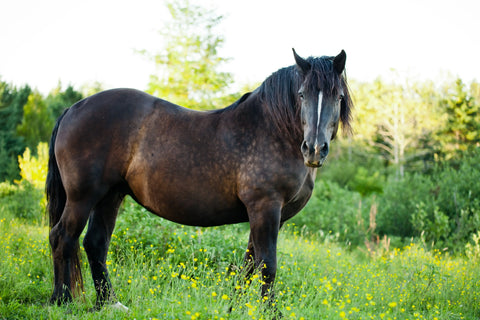
Equine Laminitis: How to Treat and Prevent It?
of reading - words
Laminitis is a common pathology encountered in horses, which affects the foot and hoof. Well known in the equine world, but often underestimated, horse laminitis is the second cause of death in equines after colic. It is a serious condition that is painful and very dangerous for the child.
What is horse laminitis?
This is an acute inflammatory congestion in the foot, caused by the cessation of irrigation of the tissues between the third phalanx and the hoof. Laminitis prevents the equine from standing, the disease can worsen to the point of perforating the sole and can even lead to fatal complications.
In the case of laminitis, total healing proves difficult. However, the earlier the disease is diagnosed, the more likely the animal is to recover. Indeed, horse laminitis must be treated properly, as quickly as possible, with the appropriate treatments. To succeed, three players must come into play: veterinarian, farrier and owner.
What are the symptoms of laminitis?
Laminitis in horsesis easy to recognize thanks to the animal's characteristic posture. To relieve himself, he shifts all his weight onto his heels and hindquarters, holding himself far back. If all four of his feet are affected, he will be more comfortable lying on his side instead of suffering the pain while standing.
Note that the manifestation of laminitis presents in different degrees of severity, it depends on its duration and intensity. However, pain symptoms occur early on in the condition. But there are cases where no symptoms are visible until the terminal phase, where the pain is intense.
Here are the symptoms of laminitis in horses in chronological order:
- Her feet are hot and painful
- His trampling is more or less frequent
- He is reluctant to move or set foot
- Lameness is important, especially when turning
- Its characteristic posture by shifting its weight onto its hindquarters
- His prostration with strong pain
- The decubitus (prone position) is common
Apart from attacks, the change in the shape of the horse's feet is the main clinical sign which shows the existence of laminitis. In addition, it is possible that his hoof bleeds on the crown, his vital prognosis is compromised in this case. However, it is advisable to immediately notify your veterinarian at the first symptoms or any doubts.
What are the causes of laminitis?
The origins of laminitis are multiple. To better treat the condition and prevent recurrences, it is always essential to identify the factors that triggered the crisis.
Overweight is the first factor that can cause laminitis in horses. On the one hand, an overweight of the horse can lead to an overload on the limbs, especially the front limbs. On the other hand, an overload on the opposite limb can occur due to severe prolonged lameness.
Une endotoxemia may also be the cause of laminitis in horses. It is a phenomenon where toxins of bacterial origin are released into the blood. Which leads to a serious existing pathology in the horse such as colic, pneumonia, diarrhea or metritis. This phenomenon also follows a poorly adapted feeding where the horse ingests too many carbohydrates. These released toxins also create vascular lesions in the feet.
In addition, laminitis can be of hormonal origin. Since in horses, two hormonal pathologies are likely to promote laminitis. Cushing syndrome occurs in horses 15 years and older, it is excess cortisol in the blood. Equine metabolic syndrome resembles human diabetes. This pathology represents insulin resistance where hyperglycemia promotes laminitis. Ponies are most affected by equine metabolic syndrome, otherwise horses of all ages can all be affected.
Finally, laminitis can also be of iatrogenic origin. Certain corticosteroids taken in high doses are at risk of triggering laminate in horses.
Generally speaking, the most common causes of laminitis are: horses being overweight or eating too rich a diet, drinking cold water, certain corticosteroid treatments, working too hard on hard ground and generalized infections.
Understand the mechanism of laminitis?
How is the horse's foot made? It includes 3 parts: the horn, which allows the farrier to trim or shoe the equine without pain. Behind, we have two layers of bones of the third phalanx, namely the navicular bone and the flexor tendon. Deep down there is sensitive flesh, podophyll. The horse's foot is healthy if the third phalanx is in its axis, parallel to the wall of the hoof and to the ground.
Acute laminitis results in inflammation, which causes pain. If the inflammation is significant, the podophyll separates from the keraphyll, which will cause the phalanx to tilt downward. X-ray can diagnose laminitis at this stage. The third phalanx once tilted, will cause congestion in the foot by compressing the blood vessel networks. After 3 to 6 weeks, the tip of the third phalanx tends to descend more and more until it pierces the sole. There the horse's prognosis will be grim. The chronic form begins and the shape of the foot changes.
What are the treatments for laminitis?
The best course of action is to treatthe cause of laminitis. If laminitis is treated alone, the treatment will not be effective.
- Makinga water dietfor cases linked to being overweight
- Reduce inflammation while promoting blood circulation withcryotherapy. This involves applying cold water or ice water to the foot or pastern. The clog can be immersed in a tray of ice water.
- Use care boots with ice or ice water inside
- Administer anti-inflammatories to alleviate pain and reduce inflammation. It is possible to add aspirin which, thanks to its thinning effect, has a positive effect on blood circulation.
- Take a draining treatment to eliminate toxins and prevent laminitis from getting worse
- trimming and shoeing are also recommended for a relieving effect. The farrier will put on a special shoe adapted to the horse's foot.
Slippers or hipsandals are also excellent alternatives to shoeing for unshod horses, especially for donkeys and ponies. With a shock-absorbing sole, these hipposandals will offer the sick equine good comfort.
Moreover, laminitis responds to a clinical diagnosis with the observation of the symptoms. For this, radiography is the best way to follow the evolution of laminitis in horses, especially in the case of chronic laminitis. Thanks to x-rays, the after-effects of laminitis are quickly detected from the third week after the onset of symptoms. Also, the vascularity of the foot can be easily observed by an x-ray called phlebogram, by injecting a contrast product. Thanks to this type of x-ray, a vascular lesion with compression of the third phalanx will be easy to detect. However, this is impractical because the clinical diagnosis is easy and more popular.
How to prevent laminitis in horses?
It is recommended to check the thickness of the soles of the feet regularly. Warning signals including a hot horse's foot with a pulse in the finger. Otherwise, to prevent laminitis, it is also important to monitor the horse nutrition. You can limit grass consumption by putting a basket in it. Likewise, make sure that the storage location is inaccessible to horses. In case your horse runs away and is caught raiding the grain supply. You need to act quickly by performing gastric lavage before symptoms appear.
To prevent laminitis in horses, it is also necessary to manage the animal's conditionespecially when it is overweight. Choose lukewarm or room temperature water over ice water, even in hot weather. Finally, if the horse has a suspected hormonal disease, it is common to carry out a screening. There are treatments for this.










